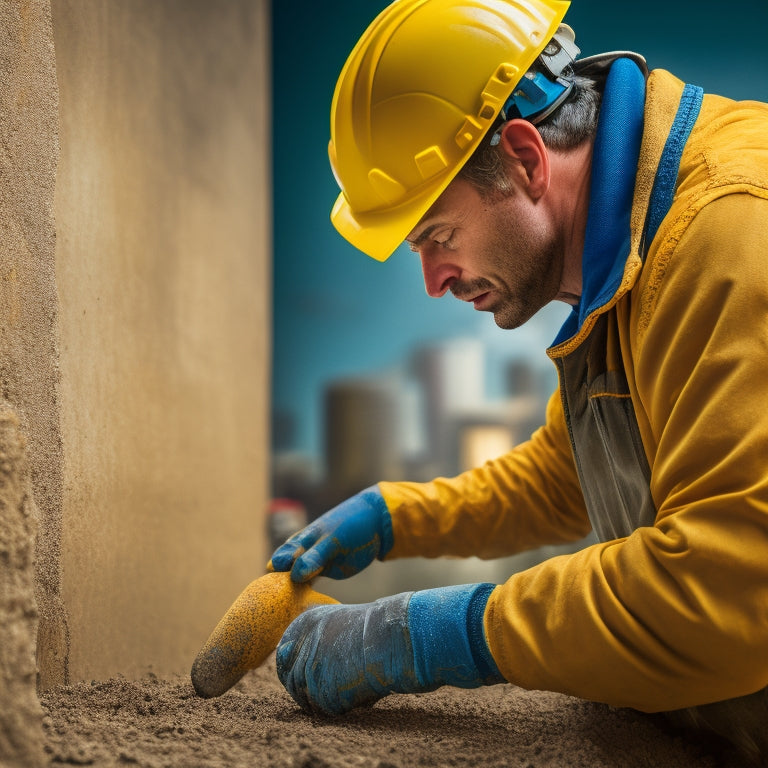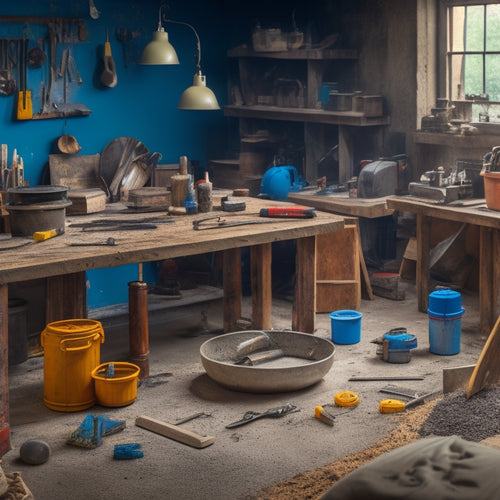
Top Tools for Leveling Concrete Foundation Walls
Share
When leveling concrete foundation walls, you'll rely on specialized tools to guarantee precision, stability, and damage prevention. Laser leveling devices project accurate level lines, while hydraulic jacking systems and wall straightening equipment provide controlled lifting and stabilization. Concrete grinding tools remove imperfections, and self-leveling compounds create a smooth surface. Precision leveling instruments, like digital and spirit levels, assure accurate measurements. Foundation wall brackets offer necessary support, and proper installation is essential. With these top tools, you'll be well-equipped to tackle concrete foundation wall leveling projects; now, explore their applications and best practices to assure a successful outcome.
Key Takeaways
• Hydraulic jacking systems strategically place jacks to lift concrete foundation walls without damage, ensuring even lifting and safety.
• Laser leveling devices and precision leveling instruments provide accurate measurements and precise alignment for leveling concrete foundation walls.
• Concrete grinding tools, such as angle grinders and floor grinders, remove imperfections and prepare surfaces for treatment and leveling.
• Self-leveling compounds address unevenness in foundation walls, providing a smooth surface with ease of use, fast drying times, and high compressive strength.
• Foundation wall brackets provide necessary support and stability, ensuring even weight distribution and secure fastening during the leveling process.
Laser Leveling Devices
When working with concrete, you'll find laser leveling devices to be vital tools for achieving precision and accuracy in your projects. These devices use laser beams to project level lines or planes, guaranteeing that your concrete foundation walls are perfectly aligned.
To get the most out of your laser leveling device, it's important to understand the significance of leveling accuracy. Even minor deviations from the desired level can lead to structural issues and costly rework. That's why you should prioritize laser calibration techniques, which involve adjusting the device to confirm it's emitting a precise level signal.
Proper calibration is key to achieving accurate results. By investing time in laser calibration, you'll be able to trust the readings and make informed decisions about your concrete project.
Hydraulic Jacking Systems
When you're working with hydraulic jacking systems, you'll need to strategically place the jacks to guarantee even lifting and avoid damaging the concrete.
You'll also need to take into account the weight of the loads you're lifting, as hydraulic jacking systems are capable of handling heavy loads, but require careful planning to do so safely.
Jack Placement Strategies
You'll need to strategically position hydraulic jacks to effectively lift and level concrete, taking into account the slab's size, thickness, and load-bearing capacity. This is vital to guarantee even distribution of weight and prevent damage to the foundation or surrounding structures.
When it comes to jack placement techniques, ideal jack spacing is key. A general rule of thumb is to space jacks 3-4 feet apart, depending on the slab's thickness and the weight it's supporting. However, this can vary depending on the specific conditions of your project.
It's essential to conduct a thorough assessment of the slab before placing jacks. Identify any weak points, such as cracks or areas of deterioration, and position jacks accordingly.
You may need to use additional support systems, like shoring or cribbing, to ensure the jacks can lift the concrete safely and efficiently. By employing the right jack placement techniques and ideal jack spacing, you'll be able to lift and level your concrete foundation walls with confidence and precision.
Lifting Heavy Loads
Hydraulic jacking systems empower you to tackle even the most challenging tasks, effortlessly lifting massive concrete slabs and foundation walls that would otherwise be impossible to maneuver.
With these systems, you can lift heavy loads with confidence, knowing that the weight is being distributed evenly and safely.
When it comes to lifting heavy loads, proper load distribution is vital. Here are three key considerations to keep in mind:
-
Weight management: Make certain that the weight of the load is evenly distributed across the jacking system to prevent uneven lifting and potential damage.
-
Jack placement: Strategically place the jacks to maximize lifting efficiency and minimize the risk of load shifting or collapse.
-
Load calculation: Accurately calculate the weight of the load to determine the required lifting capacity of the jacking system, making certain a safe and successful lift.
Concrete Grinding Tools
With the need to remove imperfections and old coatings, concrete grinding tools are essential for preparing the surface for further treatment. You'll want to select the right tools for the job to guarantee effective surface preparation. There are various concrete grinding techniques and surface preparation methods to take into account, each suited to specific tasks.
Here's a breakdown of some common concrete grinding tools:
| Tool | Description |
|---|---|
| Angle Grinder | For removing old coatings and rough imperfections |
| Floor Grinder | For large-scale surface preparation and polishing |
| Concrete Scarifier | For removing thick coatings and surface imperfections |
| Hand Grinder | For detail work and small areas |
| Diamond Grinder | For polishing and refining surfaces |
When choosing a concrete grinding tool, think about the surface area to be treated, the type of material to be removed, and the desired finish. By selecting the right tool for the job, you'll achieve ideal results and guarantee a successful foundation wall leveling project.
Foundation Wall Brackets
Two to three foundation wall brackets are typically required to level a standard foundation wall, depending on the wall's length and the amount of movement needed.
These brackets are a vital component in foundation wall repair, as they provide the necessary support and stability to guarantee a level and even surface.
When it comes to bracket installation techniques, you'll want to take into account the following:
-
Proper spacing: Verify brackets are spaced evenly apart to distribute the weight of the wall evenly.
-
Correct angle: Install brackets at the correct angle to account for any unevenness in the wall.
-
Secure fastening: Make sure brackets are securely fastened to the wall to prevent movement or shifting.
Self-Leveling Compounds
You'll need to address any unevenness in the foundation wall by applying self-leveling compounds to create a smooth, even surface. These compounds offer several self-leveling benefits, including ease of use, fast drying times, and high compressive strength. When applying self-leveling compounds, it is crucial to follow proper application techniques to achieve ideal results.
| Application Techniques | Benefits |
|---|---|
| Prepare the surface by cleaning and etching | Guarantees strong bond between compound and foundation wall |
| Apply the compound in thin layers, allowing each layer to dry | Prevents excessive shrinkage and guarantees even finish |
| Use a spirit level to verify the compound is level | Ensures a smooth, even surface |
Precision Leveling Instruments
Accurate measurements are essential when leveling concrete, and that's where precision leveling instruments come into play. These tools guarantee that your concrete foundation walls are perfectly level, which is critical for the structural integrity of your building. With precision leveling instruments, you can achieve precise measurements, detect even the slightest deviations, and make necessary adjustments.
Here are three key precision leveling instruments you should consider:
-
Digital Levels: These instruments use digital leveling technology to provide highly accurate measurements. They're easy to use, fast, and offer precise readings.
-
Laser Levels: These tools project a level line or plane, allowing you to quickly identify any deviations from the desired level. They're ideal for larger areas and offer high accuracy.
-
Precision Spirit Levels: These instruments use precision measurement techniques to provide highly accurate readings. They're often used in conjunction with other leveling tools to guarantee maximum accuracy.
Wall Straightening Equipment
When you're working on wall straightening projects, you'll need to select the right equipment to get the job done efficiently.
You'll want to take into account wall anchoring systems, which provide lateral support to walls, and hydraulic piering systems, which lift and stabilize foundations.
Wall Anchoring Systems
Wall anchoring systems, also known as wall straightening equipment, are designed to stabilize and straighten bowed or leaning walls by pulling them back into their original position.
As you work to level your concrete foundation walls, you'll find that these systems are essential for ensuring the structural integrity of your building.
When it comes to wall anchoring systems, there are several key components to evaluate:
-
Anchors: These are the devices that are installed in the soil outside your foundation wall, providing a stable point of attachment for the system.
-
Wall plates: These are the metal plates that are attached to your foundation wall, connecting it to the anchor.
-
Tie rods: These are the rods that connect the wall plate to the anchor, providing the necessary force to pull the wall back into place.
Hydraulic Piering Systems
As you explore alternatives to wall anchoring systems, hydraulic piering systems emerge as a reliable solution for lifting and stabilizing sunken or unstable concrete foundation walls.
These systems employ advanced piering techniques to transfer the weight of your foundation to more stable soil or bedrock, effectively reversing the effects of settlement. By doing so, hydraulic piering systems can restore your foundation's structural integrity and prevent further damage.
You'll find that hydraulic piering systems are particularly effective in soil stabilization, allowing for precise control over the lifting process. This is achieved through the use of hydraulic cylinders and specialized equipment, which work in tandem to apply gentle, controlled pressure to the foundation.
As a result, you can expect a high degree of accuracy and minimal disruption to your property. With hydraulic piering systems, you can rest assured that your foundation will be stabilized and lifted to its original position, providing a solid base for your home or building.
Frequently Asked Questions
Can I Level a Concrete Foundation Wall That's Severely Damaged?
You're wondering if you can level a severely damaged concrete foundation wall.
In most cases, it's not recommended to attempt leveling a severely damaged wall, as it may require extensive foundation repair techniques and wall stabilization methods.
Instead, consider consulting a professional to assess the damage and recommend the best course of action.
They'll help determine if the wall can be salvaged or if more extensive repairs are needed to guarantee the structure's integrity.
How Do I Ensure the Wall Remains Level After the Repair?
After repairing a severely damaged concrete foundation wall, you'll want to guarantee it remains level over time.
To do this, you'll need to conduct a thorough post-repair inspection to verify the wall's stability and levelness.
Additionally, implement a long-term maintenance plan, which includes regular inspections and addressing any signs of settling or shifting.
This proactive approach will help prevent future damage and maintain the wall's integrity.
Are There Any Safety Concerns When Working With Hydraulic Jacks?
You're wise to think about safety when working with hydraulic jacks.
Did you know that according to OSHA, 75% of crane accidents involve improper use of lifting equipment?
When using hydraulic jacks, you must take precautions to avoid accidents.
Verify the jack is rated for the weight you're lifting, and always position it on a firm, level surface.
Never exceed the manufacturer's recommended lifting capacity, and always use safety chains or straps to secure the load.
Can I Use Self-Leveling Compounds on Uneven Outdoor Surfaces?
When working on uneven outdoor surfaces, you can use self-leveling compounds to achieve a smooth finish.
These products offer several benefits, including ease of application, high flowability, and rapid setting times.
For outdoor applications, look for compounds specifically designed to withstand harsh weather conditions and UV exposure.
Do I Need Professional Training to Operate Precision Leveling Instruments?
You're about to commence on a precision quest, steering through the domain of leveling instruments.
To operate these precision tools, you'll need more than a steady hand; you'll require professional training to guarantee accurate readings.
Calibration is key, and without proper guidance, you'll be lost in a sea of uncertainty.
Don't risk compromising your project's integrity; invest in training to master instrument calibration and precision leveling techniques.
Conclusion
As you stand back to admire your handiwork, the once-uneven concrete foundation walls now rise like a fortress, strong and straight.
The tools of the trade, from laser leveling devices to self-leveling compounds, have done their magic. The result is a sturdy foundation, a solid base for the structure above.
With each precision-crafted component in place, you've built a bulwark against the forces of nature, a proof of your skill and expertise.
The level lines and smooth surfaces are a badge of honor, a declaration of a job well done.
Related Posts
-

Top Tools for Mixing Concrete at Home
When mixing concrete at home, you'll need a range of tools to guarantee a successful operation. Start with essential ...
-

Concrete Foundation Building Tools for Homeowners' Success
As you start your concrete foundation building project, it is vital to have the right tools to guarantee success. You...
-

Budget-Friendly Tools for DIY Decorative Concrete Profiling
You can achieve professional-grade decorative concrete results on a budget by investing in the right combination of e...


